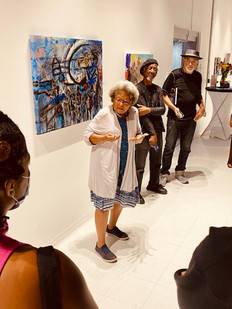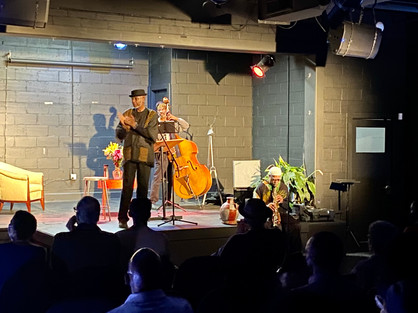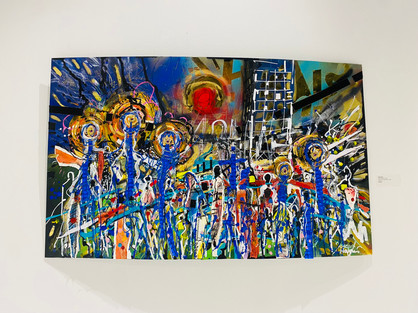Let the music lead: Oscar Harris' Jazz & Spirituality on view through Dec. 4
- Angela Oliver | ArtsXchange Media
- Oct 22, 2022
- 6 min read
Updated: Nov 9, 2022
Premier Atlanta architect Oscar Harris’ exhibition continues at ArtsXchange
Artist explores ‘Jazz & Spirituality’ in collection born during pandemic

East Point, GA — Oscar Harris’ imprint can be seen all over Atlanta: the atrium at Hartsfield-Jackson Airport, Centennial Olympic Park, and MARTA stations from the westside to the top of the perimeter. But beyond the scope of his architectural vision lies a love for jazz that shows up in every stroke of his paintbrush.
“When I go down into my studio to paint, the first thing I do is play the music I like,” said the straight-ahead jazz fan. “It starts going through me, one thing leads to another. I don’t know what paint brush I’m gonna pick up, what canvas I’m gonna pick up — I let my intuitiveness carry me.”
Jazz & Spirituality, Harris’ latest collection of mixed-media paintings, opened Oct. 9 and has been extended through Dec. 4. It is free and open to the public from 10 a.m. to 6 p.m. in the Jack Sinclair Gallery at the ArtsXchange. Harris' paintings are also available for purchase.
An intuitive abstract impressionist painter, Harris said painting and music have always been part of his life.
The Jazz & Spirituality exhibit grew from a discussion group of the same name that has met on Saturdays for years to explore the genre. The group also became a source of support for artists to continue their work when the pandemic closed venues in 2020.
“I was overcome when they suggested doing the show,” Harris said. “Since I come from the architectural world, most of my friends and relationships are in the business world. Participating in this group, I’ve found wonderful friends who have this wonderful knowledge and experience in jazz.”
Harris’ show is largely composed of paintings he created in his home studio during the pandemic shutdown. A disciple of “the second stroke,” he would often come back to his creations after a week or three to listen to them speak. Sometimes, he’d paint over the whole canvas.
“I have a dialogue with each piece,” he said. “Back and forth, back and forth, until it finally comes to a resting point. Then I question if I should put that second stroke on or not. Once I do, it amplifies the sound in my mind.”
“Are you willing to put on the second stroke? You might be afraid you'll ruin it,” he said. “But don't be afraid to put the second stroke on your life. Don’t be afraid.”
The paintings range in size and mood; some offering quiet moments of reflection, others offering exploding sounds and cityscapes.
“They’re so free-flowing,” said artist and curator Tracy Murrell. “There are some where the jazz is very visible, where you can see the music leading him. But others really bring you in.”
•••
The Jazz & Spirituality group introduced Harris to books like “The Mysticism of Sound” and “Jazz and Justice: Racism and the Political Economy of the Music,” deepening his appreciation for the genre that he’s been a lifelong fan of, he said.
“I came into the group with Mickey Mouse ears on, perked up and listening,” Harris said. “I learned about sound and how the musicians have to really believe in what they’re doing, it’s part of who they are. If they want to create a real, different sound, they have to bend the notes, like Miles (Davis). Make them special.”
JuneAnn McDonald, another member of Jazz & Spirituality, said jazz history was also foremost in her lessons from the group. Her background in tech manufacturing and logistics in Silicon Valley has very little to do with jazz and spirituality, she said jokingly.
“But I grew up in Guyana listening to jazz and I was curious whether the jazz experience here would be similar to mine, which was mainly my father and local jazz artists there,” McDonald said. “Once we started going through the pandemic, I was learning more about jazz musicians and how their journey in the 1940s,’50s, and ’60s mirrored what’s going on socially and politically.”
Beyond the heartbreak of learning about those artists, though, the Jazz & Spirituality discussions were also a cure for the group of mostly seniors.
“Early in the pandemic, seniors were the most vulnerable group; many were housebound,” McDonald said. “Our commitment to meeting on Saturdays became a way of coping with shutdown and the challenges it placed on us. The group was a way of keeping each other positive and moving forward in a time that could've been quite isolating and difficult.”
The group has been a space to share thoughts about spirituality with many definitions.
“I see spirituality as using your sweet spot — that sparkle, that thing within you,” Harris said. “When you're in your sweet spot, you’re gonna vibrate in a way that everybody can see.”
Adeyemi Toure, Jazz & Spirituality member and dramatist who performed at the exhibition events, defines spirituality as “the innate ability to interpret our lives through expression. We carry that in our genes, not only biologically, but cosmically, vibrationally.”
And for many in the group, it’s about collectivity.
“One thing we’re passing on is our collective spirituality and how do we keep that fed?” McDonald said. “Being part of the collective is key in keeping our individual spirit high. Seeing what jazz musicians did to keep their spirits high in difficult times is something we learned and continued to use. We don’t use a spiritual text or anything like that, but we work on uplifting each other. Every week.”
Founded by the Rev. Dwight Andrews at First Congregational Church in Atlanta in 2013, the Jazz & Spirituality discussion group initially met in-person but transitioned to virtual meetings at the start of the coronavirus pandemic in 2020.
Their discussions grew into new roads for artists and educators to share their knowledge, such as a member who now offers an online class exploring music communities around the world.
Being around such a varied group of people inspired Harris more than he ever imagined, he said.
“One of the most important things I’ve learned in the group is that you can’t be afraid to be yourself,” Harris said. “So with my paintings, I’m not tryin’ to imitate anybody, I’m just tryin’ to do what I do.”
•••
Harris has shared his artwork around the city in a few shows over the years, including at Auburn Avenue Research Library for African American Culture & History and the Hammonds House.
“Oscar has accomplished so much in his (architecture) career, and now seeing his career in art come alive, he’s really showing people how important it is to follow your passion,” said Murrell, who met Harris as the former Hammonds House curator. He was featured in a show of architect-artists there. “It will lead you to so many opportunities.”
Aside from his trailblazing architecture in Atlanta and the Southeast for 40 years, the Pittsburgh, Pennsylvania native is also the author of “Oscar: Memoir of a Master Architect.”
A serial entrepreneur, Harris has created hundreds of career opportunities for aspiring professionals through Turner Associates, OLH International, International Aviation Consultants, and the Atlanta Center for Creative Inquiry, which is now Spike Studio, a mentoring and training program for high schoolers aimed at diversifying the creative design, engineering and construction fields.
The studio — Harris’ nickname is Spike — began in 2004 in partnership with Carnegie Mellon, for which the alum was a trustee, the Georgia Institute of Technology and Benjamin E. Mays High School. He was inspired to begin mentoring in creative design, largely due to the absence of minorities and women studying and working in those industries, according to his website. In 2009, Spike Studio became an independent non-profit organization.
This exhibit has included a panel discussion about reaching the next generation of designers and constructors, as well as a film screening of “Whisper of the Marimba,” and performances by various community musicians and poets.
The Jazz & Spirituality group wanted to ensure there was something for varied interests, they said.
“The whole program isn’t just about our group, but the community,” Harris said.
The members hope the exhibition will give folks the same sense of community that they have found as a group.
“The group is an extension of what we can do with our potential in the future — not only the music, but the spirituality,” Toure said. “We hope to infuse the ArtsXchange with the same kind of spiritual momentum that we’ve garnered, much like you do in a temple, much like you do when you have family gatherings, much like you do in a place where you meet up. Where anybody, any community would come together, to share ideas, to be inspired.”
.png)



































